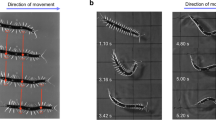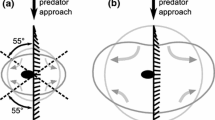Abstract
In an animal, a crucial factor concerning the arrival of information at the sensors and subsequent transmission to the effectors, is how it is distributed. At the same time, higher animals also employ proprioceptive feedback so that their respective neural circuits have information regarding the state of the animal body. In order to disseminate what this practically means for the distribution of sensory information, we have modeled a segmented swimming organism (animat) coevolving its nervous system and body plan morphology. In a simulated aquatic environment, we find that animats artificially endowed with proprioceptive feedback are able to evolve completely decoupled central pattern generators (CPGs) meaning that they emerge without any connections made to neural circuits in adjacent body segments. Without such feedback however, we also find that the distribution of sensory information from the head of the animat becomes far more important, with adjacent CPG circuits becoming interconnected. Crucially, this demonstrates that where proprioceptive mechanisms are lacking, more effective delivery of sensory input is essential.
Access this chapter
Tax calculation will be finalised at checkout
Purchases are for personal use only
Preview
Unable to display preview. Download preview PDF.
Similar content being viewed by others
References
Bäck, T., Schwefel, H.-P.: An overview of evolutionary algorithms for parameter optimization. Evolutionary Computation 1(1), 1–23 (1993)
Beauregard, M., Kennedy, P.J.: Robust simulation of lamprey tracking. In: Runarsson, T.P., Beyer, H.-G., Burke, E.K., Merelo-Guervós, J.J., Whitley, L.D., Yao, X. (eds.) PPSN 2006. LNCS, vol. 4193, pp. 641–650. Springer, Heidelberg (2006)
Blynel, J., Floreano, D.: Levels of dynamics and adaptive behavior in evolutionary neural controllers. In: From Animals to Animats 7: Proceedings of the Seventh International Conference on Simulation of Adaptive Behavior. MIT Press, Cambridge (2002)
Braitenberg, V.: Vehicles, Experiments in Synthetic Psychology, Cambridge, Mass. (1984)
Deliagina, T.G., Zelenin, V., Fagerstedt, P., Grillner, S., Orlovsky, G.N.: Activity of reticulospinal neurons during locomotion in the freely behaving lamprey. Journal of Neurophysiology 83, 853–863 (2000)
Friesen, W.O., Kristan, W.B.: Leech locomotion: swimming, crawling, and decisions. Neurobiology of Behaviour 17, 704–711 (2008)
Grillner, S., Kozlov, A., Dario, P., Stefanini, C.: Modeling a vertebrate motor system: pattern generation, steering and control of body orientation. Progress in Brain Research 165 (2007)
Ijspeert, A.J., Hollam, J., Willshaw, D.: Evolving swimming controllers for a simulated lamprey with inspiration from neurobiology. Adaptive Behavior 7(2), 151–172 (1999)
Ijspeert, A.J.: Central pattern generators for locomotion control in animals and robots: a review. Neural Networks 21(4), 642–653 (2008)
Ijspeert, A.J., Arbib, M.: Visual tracking in simulated salamander locomotion. In: Sixth International Conference of The Society for Adaptive Behavior (SAB 2000), Paris, pp. 88–97 (2000)
Jones, B., Jin, Y., Sendhoff, B., Yao, X.: Evolving functional symmetry in a three dimensional model of an elongated organism. In: Proceedings, ALife XI, Winchester, UK, pp. 305–312 (2008)
Jones, B., Jin, Y., Yao, X., Sendhoff, B.: Evolution of neural organization in a hydra-like animat. In: Köppen, M., Kasabov, N., Coghill, G. (eds.) ICONIP 2008. LNCS, vol. 5506, pp. 216–223. Springer, Heidelberg (2009)
Nishii, J.: A learning model of a periodic locomotor pattern by the central pattern generator. Adaptive Behavior 7(2), 137–149 (1999)
Pfeifer, R.: Morphological computation: Connecting brain, body, and environment. In: Ijspeert, A.J., Masuzawa, T., Kusumoto, S. (eds.) BioADIT 2006. LNCS, vol. 3853, pp. 2–3. Springer, Heidelberg (2006)
Schramm, L., Jin, Y., Sendhoff, B.: Emerged coupling of motor control and morphological development in evolution of multi-cellular animats. In: Kampis, G., Karsai, I., Szathmáry, E. (eds.) ECAL 2009, Part I. LNCS, vol. 5777, pp. 25–32. Springer, Budapest (2009)
Sfakiotakis, M., Tsakiris, D.P.: Simuun: A simulation environment for undulatory locomotion. International Journal of Modelling and Simulation (2006)
Song, W., Onishi, M., Jan, L.Y., Jan, Y.N.: Peripheral multidendritic sensory neurons are necessary for rythmic locomotion behaviour in drosophila larvae. PNAS 104(12), 5199–5204 (2007)
Author information
Authors and Affiliations
Editor information
Editors and Affiliations
Rights and permissions
Copyright information
© 2011 Springer-Verlag Berlin Heidelberg
About this paper
Cite this paper
Jones, B., Jin, Y., Sendhoff, B., Yao, X. (2011). The Effect of Proprioceptive Feedback on the Distribution of Sensory Information in a Model of an Undulatory Organism. In: Kampis, G., Karsai, I., Szathmáry, E. (eds) Advances in Artificial Life. Darwin Meets von Neumann. ECAL 2009. Lecture Notes in Computer Science(), vol 5777. Springer, Berlin, Heidelberg. https://doi.org/10.1007/978-3-642-21283-3_3
Download citation
DOI: https://doi.org/10.1007/978-3-642-21283-3_3
Publisher Name: Springer, Berlin, Heidelberg
Print ISBN: 978-3-642-21282-6
Online ISBN: 978-3-642-21283-3
eBook Packages: Computer ScienceComputer Science (R0)




